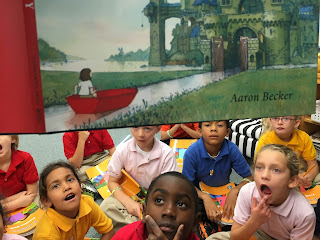I’ve got a thing for alliterations, and Wonderstruck happens to be one of my all-time favorite words (both for its meaning and the way it rolls off my tongue) and so #WonderstruckWednesdays were born several years ago! This year, I was excited to roll it out TODAY with my 2nd grade students! The main goals of Wonderstruck Wednesday throughout the year are to:
-Help students develop questioning strategies and techniques to relate to texts.
-Encourage students to develop high-level thinking and questioning habits.
-Compel students to open their eyes and consider a new idea or perspective.
-Teach students to read, annotate, understand and collect information from nonfiction texts (Close reading)
-Inspire students to walk through the world and allow themselves to become WONDERSTRUCK by the magic in every moment.
Here is a brief and very adaptable synopsis of how I roll out Wonderstruck Wednesdays! Click on the links for resources & inspirations!
First: I had the students stop and wonder. I modeled this by wondering some things out loud (Why do my hiccups go away when someone scares me? How long would it take me to walk from my house in Pennsylvania to my Grandmother’s house in New York? Why does the moon look close enough to touch some nights, but other night’s it is so far away? Why don’t I like broccoli, when my husband loves it?) Amidst their giggles, they were starting to get the idea, but still having some trouble wondering on the spot. So we played a little game called “WONDER around the room”. We talked briefly about the difference between wandering around and wondering around. Wondering around the room is purposeful and intentional. The students go to a spot in the room (armed with their questioning word prompts: Who, What, When, Where, How, Why, Does, Do, Will..) and allow inspiration to strike, and write down that wonder. Perhaps a picture of an animal in the room will get them wondering about that animal etc. I tell the students to move quickly to their first chosen location and jot a wonder.
After that, the wonders came easy and the students start bustling around the room and moving their pencils across the paper almost as fast. After a few minutes we regrouped at our seats. Next, I had the students share some of their wonders and I compiled them into one big list of questions. We discuss how sometimes we are wondering something and someone else knows the answer. Other times we can look up the answer in a book, a website, or by asking an expert, and still other times, our wonders are just “brain-candy” (nom nom nom) that we can enjoy, hypothesize and theorize about (in 2nd grade language: guess, predict & infer) but we may never really know the answers.
Next, I introduce the “Wonderwall” which serves as a place in our classroom to wonder about books we have read or content we are studying, and then try to find the answers to these wonders through research or conversation. Whenever the students hear the song “Wonderwall” by Oasis (my throwback to my own “wonder years” and the music of my youth) they can jot down a wonder relating to what we are currently talking about, and post it to the wall. If ever a student feels that they know or can find the answer to a posted “Wonder” they let the class know! (this part comes later and is very exciting!!)
To demonstrate this, I shared the story “Journey” with my students. I modeled a few wonders but mostly left the story up to the students to interpret and consider. They posted their wonders on the WonderWall at the end of the story, and spent a few minutes reading each others wonders as well (For more on the exciting turn this took, when the author responded to our tweets, check out my blog on Journeys).
Later, with the stage set for questioning, exploring and wondering, I introduced my students to our main tool in Wonderstruck Wednesdays: Wonderopolis.org. Wonderopolis is a tremendous resource of kid-friendly non-fiction texts having to do with just about every topic anyone has ever wondered about. As an introduction, I chose a Wonder of the Day to display on the smartboard. We watch the intro video (included on most “Wonders”) and made a list of things we already know about this topic on our trifold. Next, we read the text together. I had the students read along as I read it aloud. In the spirit of Close Reading, the students read this text several times. They read it a second time with a partner and highlight important facts. A third time they choral read it and circle unfamiliar words. We discuss the new words as a whole group and create definitions and pictures to help with comprehension & retention. Then we identified the main idea of the text, and filled in some supporting details from the facts that they had underlined earlier. Through the course of the school year, our Wonderopolis time will evolve. Sometimes we will look specifically for Facts Vs. Opinions, Cause/Effect, Sequencing, Author’s Purpose, and any other Reading skill we happen to be studying. Also, although I will lead the students through this WonderTime in a whole group setting for now, we will eventually work towards the students searching the site independently and interacting with the text on their own with differentiated expectations/graphic organizers to complete.
How do you encourage a sense of WONDER in YOUR students?
Trifold Resource: Created by UpperGradesAreAwesome









No comments :
Post a Comment